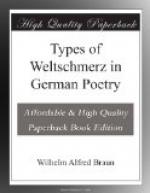Pluemacher maintains: “Der Weltschmerz ist entweder die absolute Passivitaet, und die Klage seine einzige Aeusserung, oder aber er verpufft seine Kraefte in rein subjectivistischen, eudaemonischen Anstrengungen,"[282]—a characterization which certainly holds good in the case of Lenau and Hoelderlin respectively. Hoelderlin, although in a visionary, idealistic way, remains, en in his Weltschmerz, altruistic and constructive. Lenau is passive, while Heine is solely egoistic and destructive.
FOOTNOTES:
[Footnote 181: “Studien und Wandertage,” Frauenfeld, Huber, 1884.]
[Footnote 182: Vol. II, p. 265.]
[Footnote 183: “Franzoesische Maler. Gemaelde-Ausstellung in Paris, 1831.” Heines Saemmtliche Werke, mit Einleitung von E. Elster. Leipzig, Bibliogr. Inst., 1890. (Hereafter quoted as “Werke.”) Vol. IV, p. 61.]
[Footnote 184: “Selina, oder ueber die Unsterblichkeit,” II, p. 132.]
[Footnote 185: “Heinrich Heines Krankheit und Leidensgeschichte.” Eine kritische Studie, von S. Rahmer, Dr. Med., Berlin, 1901.]
[Footnote 186: “Das Liebesleben Hoelderlin’s, Lenaus, Heines.” Berlin, 1901.]
[Footnote 187: Rahmer, op. cit. p. 45.]
[Footnote 188: Rahmer, p. 46.]
[Footnote 189: Werke, Vol. III, p. 194.]
[Footnote 190: Karpeles ed. Werke (2. Aufl.) VIII, p. 441.]
[Footnote 191: Ibid., p. 378.]
[Footnote 192: Ibid., p. 520.]
[Footnote 193: Karpeles ed. Werke, IX, p. 371.]
[Footnote 194: Ibid., p. 374.]
[Footnote 195: Ibid., p. 459 ff.]
[Footnote 196: Ibid., p. 513.]
[Footnote 197: Ibid., p. 475.]
[Footnote 198: Werke, Vol. I, p. 72, Nos. 18 and 19.]
[Footnote 199: Werke, Vol. I, p. 123, No. 62.]
[Footnote 200: Lenaus Werke, Vol. I, p. 257 ff.]
[Footnote 201: Werke, Vol. I, p. 37.]
[Footnote 202: Ibid., Vol. II, p. 11.]
[Footnote 203: Ibid., Vol. I, p. 97.]
[Footnote 204: Ibid., Vol. I, p. 177.]




